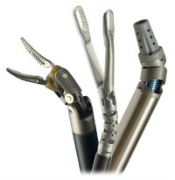The Da Vinci Robot
Why use the da Vinci Robotic Surgical System?
With the da Vinci Surgical System presented by Intuitive Surgical, surgeons operate using just a few small incisions. The system offers a magnified 3D high-definition vision along with tiny wristed instruments that bend and rotate far greater than the human wrist. As a result, da Vinci enables the surgeon to operate with enhanced vision, precision, dexterity and control.
Minimally invasive da Vinci system uses the latest in surgical and robotic technologies. The system is beneficial for performing routine and complex surgeries. The surgeon is 100% in control of the da Vinci System, which translates his hand movements into smaller, more precise movements of tiny instruments inside the body thus taking surgery beyond the limits of the human hand.
Surgeries performed by the da Vinci Surgical System has been proven to have a
- Shorter hospital stay.
- Less pain and lesser need for narcotic pain medication.
- Less blood loss.
- Faster recovery and earlier return to daily activities.
- Smaller incisions with minimal or virtually no scarring.
- Lesser wound complications.
Benefits of using the da Vinci Surgical System
- Higher (up to 10 times) magnification of the operative field – To give the surgeon a closer view of the area of the operation.
- 3D High Definition visualization to appreciate depth.
- Wristed articulating instrumentation – mechanical wrists that bend and rotate to mimic the movements of the human wrist – allowing the surgeon to make small, precise movements inside the body
- Decrease in surgeon fatigue – the surgeon operates sitting on a console that controls the robot.
- Fluorescence (Firefly) technology allows a better and clearer view of certain vital structures.
- The surgeon has control of robotic 3 arms.
Surgeons have to undergo specialized training prior using the da Vinci Surgical System. Additional specialized training is needed to use the single site technology.
See if your Surgeon is trained to operate using the da Vinci Surgical System
Components of the da Vinci Surgical System
Surgeon Console

- Using the da Vinci Surgical System, the surgeon operates seated comfortably at a console while viewing a high definition, 3D image inside the patient’s body.
- The surgeon’s fingers grasp the master controls below the display with hands and wrists naturally positioned relative to his or her eyes.
- The system seamlessly translates the surgeon’s hand, wrist and finger movements into precise, real-time movements of surgical instruments
Patient-side Cart

- The patient-side cart is where the patient is positioned during surgery. It includes either three or four robotic arms that carry out the surgeon’s commands.
- The robotic arms move around fixed pivot points.
- he system requires that every surgical maneuver be under the direct control of the surgeon. Repeated safety checks prevent any independent movement of the instruments or robotic arms.
Endowrist Instruments

- A full range of Endowrist instruments is available to the surgeon while operating.
- The instruments are designed with seven degrees of motion – a range of motion even greater than the human wrist
- Each instrument has a specific surgical mission such as clamping, suturing and tissue manipulation.
- Quick-release levers speed instrument changes during surgery.
Vision System

- The vision system is equipped with a high-definition, 3D endoscope (flexible tube with a camera and light at the tip) and image processing equipment that provides true-to-life images of the patient’s anatomy.
- A view of the operating field is available to the entire OR team on a large viewing monitor (vision cart). This widescreen view provides the surgical assistant at the patient’s side with a broad perspective and visualization of the procedure.
